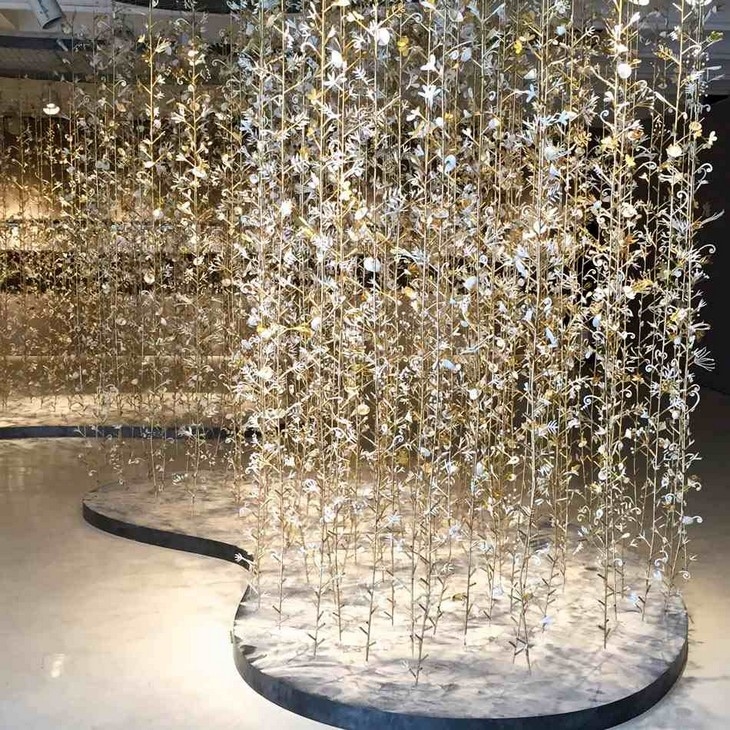On April 11th 2015 Galleria Carla Sozzani presented the Hanging Garden, the new environmental installation by Kris Ruhs. Hanging Garden is a collection of porcelain blooms and hand forged brass vines that captures the visual cacophony of a spring garden.
One of the hallmarks of this artist’s work has been his insistence that we see the presence of his materials. Fire and earth, water and iron, air and light are all apparent. But here, the delicate nature of the subject, a riot of flowers and vines, creates a subtle balance in visual delicacy between the elemental presence of his materials and the apparent fragility of these porcelain shapes and tangle of vines that express the ephemeral magnificence of nature.
On an environmental note, an area of concern for Ruhs, the beauty of the whole installation references the planet itself. Primal, elemental, and ephemeral. As Ruhs has always said, “Nothing can beat nature”.
Kris Ruhs Biography
1952 – Born in New York City to parents of German extraction.
1972 -1975. Attends the School of Visual Arts, New York City.
1972 -1996. Studio in New York.
1996 – Present. Studios in Milan and Paris.
While attending the School of Visual Arts, Ruhs begins his explorations as an artist in New York City in the Seventies – when visually there is a movement to bring back the basics of creation in various media and expose the process of creation in action as much as the results of finished works. In these years Ruhs quickly moves beyond paper and paint as a medium for expression.
He begins his first series of sculptures inspired by the wood discarded in the streets next to his studio on lower Broadway. Discards of various shapes and sizes become favored materials for him.
While living in New York City in the late 1970’s, Ruhs’ friendship with legendary jewelry designer Robert Lee Morris of Art Wear lead him to begin to explore his own personal concepts of wearable art. Ruhs has over the years built up a sizable body of work, each piece hammered, shaped and composed in a way that echoes the artist’s creation of his larger sculptures.
Ruhs strong ability to bring out the expressive potential of structure, of materials and of color allows him to successfully cross the usual boundaries between the three dimensions of sculpture and the two dimensions of painting; the surfaces of paper, wood or canvas and the blurring of reality between abstraction and representation.
This exploration of process and its expression will lead to several aesthetic issues with which Ruhs still deals. Light in movement – in process – and light at rest on the surface of a work reveals another layer of process in time. Materials and light might move – materials and light might remain at rest. Their process of growth and dissolution interrupted and redirected by the artist as partner and revealer of their own internal process, not his. The directness of this dialogue between the artist and his materials leads to Ruhs’ability to use anything as material and adapt any technique to his imaginative process. The result of his art is that the formal discipline and mastery of his skills as an artist is reflected in the mystery of the process of time and space on objects that he reveals to us in each piece of his work.
 THE HANGING GARDEN / KRIS RUHS
THE HANGING GARDEN / KRIS RUHS THE HANGING GARDEN / KRIS RUHS
THE HANGING GARDEN / KRIS RUHS THE HANGING GARDEN / KRIS RUHS
THE HANGING GARDEN / KRIS RUHS THE HANGING GARDEN / KRIS RUHS
THE HANGING GARDEN / KRIS RUHS THE HANGING GARDEN / KRIS RUHS
THE HANGING GARDEN / KRIS RUHS THE HANGING GARDEN / KRIS RUHS
THE HANGING GARDEN / KRIS RUHS THE HANGING GARDEN / KRIS RUHS
THE HANGING GARDEN / KRIS RUHS THE HANGING GARDEN / KRIS RUHS
THE HANGING GARDEN / KRIS RUHS THE HANGING GARDEN / KRIS RUHS
THE HANGING GARDEN / KRIS RUHSREAD ALSO: LUXURY IN THE GOLDEN AGE: ASIA - AMSTERDAM PRESENTED IN THE RIJKSMUSEUM